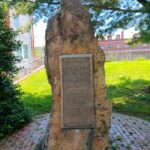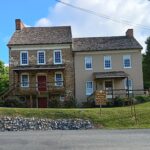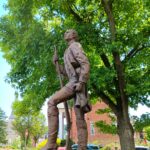 While I often feel like I am running around in circles, that is not what I meant by the title of this article. Anyone who has been around me for any length of time knows I enjoy finding connections between places, events, and people. And none have been more fun than chasing the roots of my Howell family in western Maryland in the days before the American Revolution.
While I often feel like I am running around in circles, that is not what I meant by the title of this article. Anyone who has been around me for any length of time knows I enjoy finding connections between places, events, and people. And none have been more fun than chasing the roots of my Howell family in western Maryland in the days before the American Revolution.
Many years ago, in the days before the internet (yes, I am that old); I began tracing my family. By going to the library and writing letters to genealogical societies, I learned about William Howell, who lived in Oldtown, Maryland, and died in 1811 in Allegany County. I traced my ancestry to his son James, and now, I have his father’s will. The document also mentioned his brothers, Levi and Elijah. While James is a common name, the combination of the three led me to believe I was on the right track. DNA testing has confirmed a match to others who trace their lineage to this family.
Being interested in the American Revolution and Colonial history in general, I was excited to discover that William and his oldest son had served in a company of Maryland riflemen under Captain Michael and Sergeant Daniel Cresap. As I tried to determine if my family had any connection to theirs, I learned about their father, Thomas Cresap, or the Maryland Monster, as the Pennsylvanians called him.
At a time when the powerful English nobles were making land grabs in the American Colonies, skirmishes broke out along the contentious border between Pennsylvania and Maryland over which colony the people owed their taxes. Enter a young man recently arrived from England who became the voice of Maryland. The land grants given to the Penns and the Calverts overlapped, and Thomas Cresap led a one-man campaign to prove he lived in Maryland. In 1763, Charles Mason and Jeremiah Dixon arrived and settled the matter, putting an end to eighty years of skirmishes. Thomas’ antics are enough to fill another post, but suffice it to say he earned his nickname.
Years later, I sat down to write a historical mystery set along the Mason-Dixon survey. While doing research for Death on the Line and looking to include historical tidbits, I was reacquainted with Thomas Cresap. No one was more anxious to determine the location of the border than he was. And who could leave out such a fascinating historical figure? While the murder mystery and dialogue in my story are fictitious, the antics of Thomas Cresap mentioned in the book can be found in historical records.
 In researching Sign of Nine Stripes, I learned a lot about the Sons of Liberty. This secret society met beneath trees dubbed Liberty Trees in each colony where they discussed unfair taxation and political policies. Maryland’s tree was in Annapolis. However, in honor of his support for the organization and his efforts to repeal the Stamp Act, a tree was planted near his home in Oldtown. This tree is a descendant of the Tulip Poplar in Annapolis.
In researching Sign of Nine Stripes, I learned a lot about the Sons of Liberty. This secret society met beneath trees dubbed Liberty Trees in each colony where they discussed unfair taxation and political policies. Maryland’s tree was in Annapolis. However, in honor of his support for the organization and his efforts to repeal the Stamp Act, a tree was planted near his home in Oldtown. This tree is a descendant of the Tulip Poplar in Annapolis.
Before we returned to the U.S. last spring, we visited our son, Ian, and his wife, Claire, in Yorkshire, England. One of our outings was to nearby Skipton Castle. We had a great time at the castle, but I was also curious about visiting the town. Why? It was the birthplace of Thomas Cresap, who snuck aboard a ship in 1717 and sailed to the colonies. Knowing the character he became; I have to wonder if he was only one step ahead of the law back home. Why else would a fifteen-year-old carpenter’s apprentice run away? But here he was again, and little did I know, it would not be the last time our paths would cross.
of our outings was to nearby Skipton Castle. We had a great time at the castle, but I was also curious about visiting the town. Why? It was the birthplace of Thomas Cresap, who snuck aboard a ship in 1717 and sailed to the colonies. Knowing the character he became; I have to wonder if he was only one step ahead of the law back home. Why else would a fifteen-year-old carpenter’s apprentice run away? But here he was again, and little did I know, it would not be the last time our paths would cross.
 Once we settled in our new home, Dave and I joined the Archaeological Society of Maryland. When they announced the site for this year’s Field School, I knew I had to join the project. Ground penetrating radar, combined with test pits, had revealed the location of Thomas Cresap’s fortified house in Oldtown, Maryland, the same town where my Howells lived. I jumped on the chance to be a part of the dig and signed up that day. I came here a few days early to do some family research. Today, I drove to Oldtown to see his son’s home built in 1762, which still stands in the town. It is one of the few colonial homes left in Maryland.
Once we settled in our new home, Dave and I joined the Archaeological Society of Maryland. When they announced the site for this year’s Field School, I knew I had to join the project. Ground penetrating radar, combined with test pits, had revealed the location of Thomas Cresap’s fortified house in Oldtown, Maryland, the same town where my Howells lived. I jumped on the chance to be a part of the dig and signed up that day. I came here a few days early to do some family research. Today, I drove to Oldtown to see his son’s home built in 1762, which still stands in the town. It is one of the few colonial homes left in Maryland.
Yesterday, after fighting the traffic escaping Washington D.C., I felt like taking a walk around Cumberland, where I booked a hotel. Those of you who regularly read my posts may recall I recently wrote about George Washington’s early career. As a young officer, he was sent to build and defend a fort in this area. I learned he had been here before, in 1748, as part of a survey team hired by Colonel William Fairfax. At the age of 16, young Washington had stayed in the home of Thomas Cresap.
 A memorial stone to Thomas stands in the town along the banks of the Potomac River. In the morning, I am off to dig up his home, but that will be another article.
A memorial stone to Thomas stands in the town along the banks of the Potomac River. In the morning, I am off to dig up his home, but that will be another article.

One of your best articles to me because of the various twists involving people in your no vels.
Thanks!
Good morning Carol. As always a great article. Informative, I love how you piece together the details and facts into your articles. It’s funny how they seem to relate to your family or your books.
Thanks! It does seem like it always comes back around to the same things. Right?